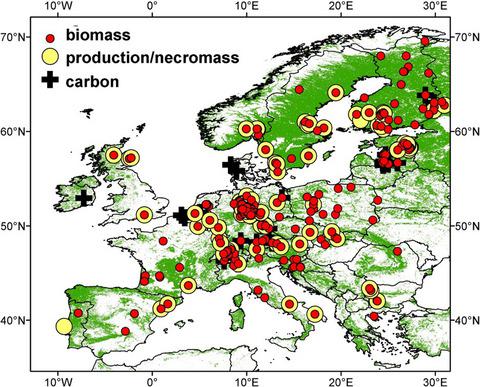Our official English website, www.x-mol.net, welcomes your
feedback! (Note: you will need to create a separate account there.)
Improving models of fine root carbon stocks and fluxes in European forests
Journal of Ecology ( IF 5.3 ) Pub Date : 2020-01-10 , DOI: 10.1111/1365-2745.13328 Mathias Neumann 1 , Douglas L Godbold 2, 3 , Yasuhiro Hirano 4 , Leena Finér 5
中文翻译:

改进欧洲森林细根碳储量和通量模型
更新日期:2020-01-11
Journal of Ecology ( IF 5.3 ) Pub Date : 2020-01-10 , DOI: 10.1111/1365-2745.13328 Mathias Neumann 1 , Douglas L Godbold 2, 3 , Yasuhiro Hirano 4 , Leena Finér 5
Affiliation

|
- Fine roots and above‐ground litterfall play a pivotal role in carbon dynamics in forests. Nonetheless, direct estimation of stocks of fine roots remains methodologically challenging. Models are thus widely used to estimate these stocks and help elucidate drivers of fine root growth and turnover, at a range of scales.
- We updated a database of fine root biomass, necromass and production derived from 454 plots across European forests. We then compared fine root biomass and production to estimates obtained from 19 different models. Typical input variables used for the models included climate, net primary production, foliage and above‐ground biomass, leaf area index (LAI), latitude and/or land cover type. We tested whether performance could be improved by fitting new multiple regression models, and explored effects of species composition and sampling method on estimated fine root biomass.
- Average fine root biomass was 332 g/m2, and necromass 379 g/m2, for European forests where the average fine root production was 250 g m−2 year−1. Carbon fraction in fine roots averaged 48.4%, and was 1.5% greater in broadleaved species than conifers.
- Available models were poor predictors of fine root biomass and production. The best performing models assumed proportionality between above‐ and below‐ground compartments, and used remotely sensed LAI or foliage biomass as key inputs. Model performance was improved by use of multiple regressions, which revealed consistently greater biomass and production in stands dominated by broadleaved species as well as in mixed stands even after accounting for climatic differences.
- Synthesis. We assessed the potential of existing models to estimate fine root biomass and production in European forests. We show that recalibration reduces by about 40% errors in estimates currently produced by the best available models, and increases three‐fold explained variation. Our results underline the quantitative significance of fine roots (live and dead) to the global carbon cycle.
中文翻译:

改进欧洲森林细根碳储量和通量模型
细根和地上凋落物在森林碳动态中发挥着关键作用。尽管如此,直接估计细根储量在方法上仍然具有挑战性。因此,模型被广泛用于估计这些库存,并帮助阐明各种规模的细根生长和周转的驱动因素。
我们更新了来自欧洲森林 454 个地块的细根生物量、死灵物质和产量的数据库。然后,我们将细根生物量和产量与 19 个不同模型获得的估计值进行比较。用于模型的典型输入变量包括气候、净初级生产力、树叶和地上生物量、叶面积指数(LAI)、纬度和/或土地覆盖类型。我们测试了是否可以通过拟合新的多元回归模型来提高性能,并探讨物种组成和采样方法对估计细根生物量的影响。
欧洲森林的平均细根生物量为332 g/m 2 ,坏死物为379 g/m 2 ,其中平均细根产量为250 gm -2年-1 。细根中的碳含量平均为 48.4%,阔叶树种比针叶树种高 1.5%。
现有模型对细根生物量和产量的预测效果较差。表现最好的模型假设地上和地下隔间之间成比例,并使用遥感 LAI 或树叶生物量作为关键输入。通过使用多重回归改进了模型性能,显示即使在考虑了气候差异后,以阔叶树种为主的林分以及混合林分的生物量和产量始终较高。
合成。我们评估了现有模型估计欧洲森林细根生物量和产量的潜力。我们表明,重新校准可将目前最佳可用模型产生的估计误差减少约 40%,并将解释的变异增加三倍。我们的结果强调了细根(活的和死的)对全球碳循环的定量重要性。











































 京公网安备 11010802027423号
京公网安备 11010802027423号